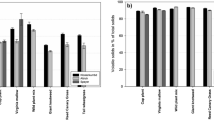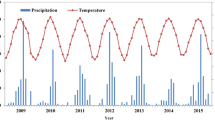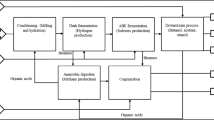Abstract
In current times, we heavily rely on the use of fossil fuels, which bring negative impacts on climate change; therefore, it is essential to place more focus on all renewable alternatives, especially bioenergy crops. This study is focused on the quantification and evaluation of biogas production from either corn or sweet sorghum, as well as their combination. The field data were obtained from 2013 to 2016 in central Ukraine. The Buswell equation was used for the calculation of the theoretical biogas and methane potential. The results show that corn and sweet sorghum were intercropping and had higher on 8.5–37.8% of green mass, and 9.5–28.7% estimated yield of biogas compared to the single use of these crops. Due to the higher dry matter content, the specific yield of biogas per unit of applied corn silage was higher by 33.7–50.6% compared to sweet sorghum. However, biogas yield was increased by 9.2–13.0% when using a mixture of corn silage and sweet sorghum compared to sweet sorghum alone. Results of biogas and methane yield per unit area show that the highest rates, 10.2 and 5.9 thousand m3/ha, were obtained in the combined growing of hybrids of sweet sorghum Dovista and corn Monica 350. Even though theoretical calculations have some limitations, the gathered results provide essential information on the potential of the examined green mass for biogas potential in Ukraine. Such information are crucial to be known for economic and energy reasons.




Similar content being viewed by others
References
Kaletnik GM, Pryshlyak VM (2010) Biofuels: efficiency of their production and consumption in the agro-industrial complex of Ukraine. Ki.ev. 327 p
Toklu E (2017) Biomass energy potential and utilization in Turkey. Renew Energy 107:235–244. https://doi.org/10.1016/j.renene.2017.02.008
Buswell AM, Mueller HF (1952) Mechanism of methane fermentation. Ind Eng Chem №44(3):550–552
Boyle WC (1977) Energy recovery from sanitary landfills. In: Schlegel HG, Barnea J (eds) Microbial energy conversion. Pergamon Pres, New York, pp 119–138
Achinas S, Euverink GJW (2016) Theoretical analysis of biogas potential prediction from agricultural waste. Resour-Effic Technol №2(3):143–147. https://doi.org/10.1016/j.reffit.2016.08.001
Luna-deRisco M, Normak A, Orupold K (2011) Biochemical methane potential of different organic wastes and energy crops from Estonia. Agron Res 9(1–2):331–342
Mahnert P, Linke B (2009) Kinetic study of biogas production from energy crops and animal waste slurry: effect of organic loading rate and reactor size. Environ Technol 30(1):93–99. https://doi.org/10.1080/09593330802246640
Kacprzak A, Krzystek L, Ledakowicz S, Księżak J (2010) Evaluation of biochemical potential (BMP) of various energy crops. In: Proceedings of the 3-rd international conference on engineering for waste and biomass valorisation, Beijing, China, p. 5 2010
Bassam N (1998) Energy plant species-their use and impact on environment. London. 200 p
Scholz V, Ellerbrock R (2002) The growth productivity, and environmental impact of the cultivation of energy crops on sandy soil in Germany. Biomass Bioenergy №23:81–92
Heiermann M, Plöchl M, Linke B, Schelle H, Herrmann C (2009) Biogas crops – part I: specifications and suitability of field crops for anaerobic digestion. Agric Eng Int CIGR J Vol. XI:1087–1093
Dubrovskis V, Plume I, Bartusevics J, Kotelenecs V (2010) Biogas production from fresh maize biomass. Engineering for Rural Development, Jelgava, рр 220–225
Mazurkiewicz J, Marczuk A, Pochwatka P, Kujawa S (2019) Maize straw as a valuable energetic material for biogas plant feeding. Materials (Basel) №12:3848
Meyer-Aurich A, Lochmann Y, Klauss H, Prochnow A (2016) Comparative advantage of maize- and grass-silage based feedstock for biogas production with respect to greenhouse gas mitigation. Sustainability 8(7):617
Bartuševics J, Gaile Z (2010) Effect of silaging on chemical composition of maize substrate for biogas production. In Annual 16-th International Scientific Conference Proceedings: Research for rural development, Jelgava, Latvia, Vol. 1. pp. 42–47 19–21 May 2010
Amon T, Amon B, Kryvoruchko М, Zollitsch W, Mayer K, Gruber L (2007) Biogas production from maize and dairy cattle manure – Influence of biomass composition on the methane yield. Agric Ecosyst Environ №118:173–182
Schittenhelm S (2010) Effect of drought stress on yield and quality of maize/sunflower and maize/sorghum intercrops for biogas production. J Agron Crop Sci №196:253–261
Serra P, Giuntoli J, Agostini A, Colauzzi M, Amaducci S (2017) Coupling sorghum biomass and wheat straw to minimise the environmental impact of bioenergy production. J Clean Prod 154:242–254. https://doi.org/10.1016/j.jclepro.2017.03.208
Royik MV, Hanzhenko OM, Tymoschuk VL (2014) Concept of biogas production from bioenergy plants in Ukraine. Bioenergetics 2:6–8
Geletukha GG, Zheleznaya TA, Kucheruk PР, Oleynik EN, Triboy AV (2015) Bioeneregetika in Ukraine: current state and prospects for development. Part 2. Ind Heat Eng Vol. 37(№ 3):65–73
Masse L, Masse DI, Beaudette V, Muir M (2005) Size distribution and composition of particles in raw and anaerobically digested swine manure. Trans ASAE №48(5):1943–1949
Weiland P (2003) Production and energetic use of biogas from energy crops and wastes in Germany. Appl Biochem Biotechnol №109(1–3):263–274
Kažimírová V, Gaduš J, Giertl T (2018) Verification of suitability of substrate composition for production and quality of biogas. Acta Technologica Agriculturae №3:115–118
Amon T, Kryvoruchko V, Amon B, Bodiroza V, Zollitsch W, Boxberger J (2006) Biogas Production from Energy Maize. Landtechnik №2:86–87
Mahmood A, Ullah H, Ijaz M, Naeem AS, Honermeie B (2013) Evaluation of sorghum cultivar for biomass and biogas production. Aust J Crop Sci №7(10):1456–1462
Podkówka W, Podkówka Z, Kowalczyk-Ju’sko A. Pasyniuk P 2012 Agricultural biogas renewable energy source. Theory and practical application. Wydawnictwo PWRiL рр. 147–152 2012
Mazur VA, Pantsyreva HV, Mazur KV, Myalkovsky RO, Alekseev OO (2020) Agroecological prospects of using corn hybrids for biogas production. Agron Res 18:177–182 (in press)
Gerber M, Span R (2008) An analysis of available mathematical model for anaerobic digestion of organic substances for production of biogas. International Gas Union Research conference, Paris. №1. 1294–1324 2008
Baserga U (1998) Landwirtschaftliche Co-Vergärungs-Biogasanlagen. FAT-Berichte Nr. 512, Eidg. Forschungsanstalt für Agrarwirtschaft und Landtechnik, Tänikon, Schweiz
Keymer U, Schilcher A (2003) Biogasanlagen: Berechnung der Gasausbeute von Kosubstraten. Bayrische Landesanstalt für Landwirtschaft
Roati C, Fiore S, Ruffino B, Marchese F, Novarino D, Zanetti MC (2012) Preliminary evaluation of the potential biogas production of food-processing industrial wastes. Am J Environ Sci 8(3):291–296
Velázquez-Martí B, Meneses-Quelal OW, Gaibor-Chavez J, Niño-Ruiz Z (2003) Review of mathematical models for the anaerobic digestion process, anaerobic digestion. J Rajesh Banu, IntechOpen 2018. https://doi.org/10.5772/intechopen.80815
Kowalczyk-Juśko A, Pochwatka P, Zaborowicz M, Czekała W, Mazurkiewicz J, Mazur A, Janczak D, Marczuk A, Dach J (2020) Energy value estimation of silages for substrate in biogas plants using an artificial neural network. Energy 202:117729
Abeuov SK (2014) Polyspecific crops, especially unity and contradictions. Potential Mod Science 6:10–13 (in Russian; Polividovye posevy, osobennosti edinstva i protivorechij)
Drozdova OV (2015) Productivity and chemical composition of green mass of intercropping crops of different corn and sorghum hybrids. Sci Tech Bull №114:69–73
Samarappuli D, Berti MT (2018) Intercropping forage sorghum with maize is a promising alternative to maize silage for biogas production. J Clean Prod 194:515–524
Bartusevics J, Gaile Z (2012) Maize production for biogas in Latvia. Proceedings of the International Scientific Conference on Renewa, 51–56 р 2012
Hermuth J, Janovská D, Strašil Z, Usťak S, Hýsek J (2012) Sorghum bicolor (L.) Moench: possibilities of utilization in Czech Republic conditions. VÚRV. Praha, 47 р
Klimiuk E, Pokój T, Budzyňski W, Dubis B (2010) Theoretical and observed biogas production from plant biomass of different fibre contents. Bioresour Technol №101:9527–9535
Kára J, Pastorek Z, Přibyl E (2007) The production and utilization of biogas in agriculture. VÚZT. Praha. 120 р
Kuglarz K, Bury M, Kasprzycka A, Lalak-Kańczugowska J (2019) Effect of nitrogen fertilization on the production of biogas from sweet sorghum and maize biomass. Environ Technol №15:1–11
Acknowledgments
We are thankful to the Czech Development Cooperation support, which allowed this scientific cooperation to start. Furthermore, this research was supported by the Internal Grant Agency of the Faculty of Tropical AgriSciences, Czech University of Life Sciences Prague, project number [20205008].
Author information
Authors and Affiliations
Contributions
Mykola Grabovskyi: supervision, methodology, investigation, and writing—original draft. Mykola Lozinskyi: formal analysis and data curation. Tetiana Grabovska: methodology, formal analysis, and visualization. Hynek Roubík: conceptualization, validation, resources, and writing, review and editing, project administration, and funding acquisition.
Corresponding authors
Additional information
Publisher’s note
Springer Nature remains neutral with regard to jurisdictional claims in published maps and institutional affiliations.
Rights and permissions
About this article
Cite this article
Grabovskyi, M., Lozinskyi, M., Grabovska, T. et al. Green mass to biogas in Ukraine—bioenergy potential of corn and sweet sorghum. Biomass Conv. Bioref. 13, 3309–3317 (2023). https://doi.org/10.1007/s13399-021-01316-0
Received:
Revised:
Accepted:
Published:
Issue Date:
DOI: https://doi.org/10.1007/s13399-021-01316-0




